10 Fun Baboon Facts
Table of Contents
Not many people can rattle off a list of baboon facts. Everyone knows that baboons are cute, and they are fun to watch at the zoo. Beyond that, many people don’t have a lot of knowledge about these interesting creatures. Here are ten fun baboon facts to whet your appetite to learn more about this animal.
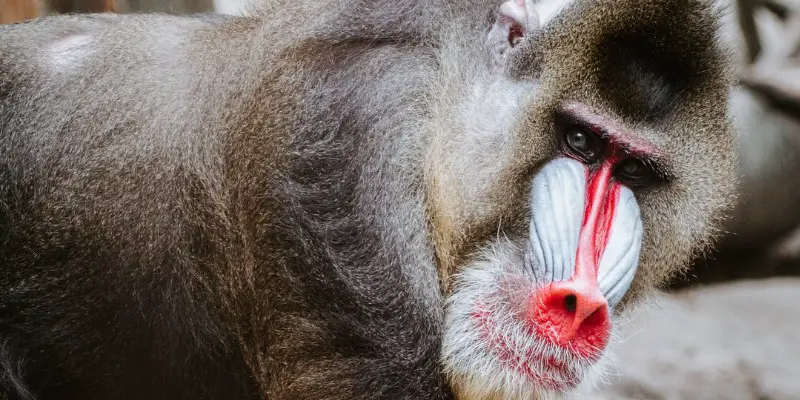
The term baboon monkey is not heard often, usually the species is referred to simply as a baboon. Both are correct, baboon monkey perhaps being the most correct or precise, as the baboon is indeed a species of monkey in the family of primates. The baboon monkey is different from most all of its near relatives however in that is primarily a ground dweller, whereas the vast majority of other species of monkey are tree dwellers. The baboon will climb trees in search of food as well as for safety and sometimes a place to sleep, but spends most of its waking hours on the ground. Although the baboon has a tail, as a monkey of course should, it is not a prehensile tail, in other words, the baboon cannot use its tail to grasp things. It cannot hang from a tree branch by its tail.
5 Species of Baboon
There are 5 different species of baboons, ranging from the smallest, the Guinea Baboon which weighs about 30 pounds at maturity, to the largest, the Chacma Baboon which tips the scales at 90 pounds. Only the Mandrill and Mandrillus are larger monkeys. Even though both are sometimes called baboons, both species belong to a different branch of the monkey family altogether. A favorite baboon monkey in zoos, because of its appearance, is the Hamadryas baboon, the male of the species being renowned for its flowing white mane.
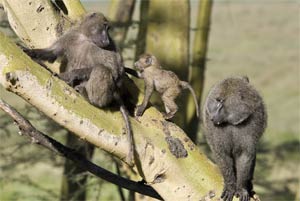
They Live in Family Units (and the females are in charge)
Flock? Herd? Pack? – Baboons travel in groups, called a troop. A troop may consist of a half dozen or so baboons, but more typically there will be on the order of 50 or more baboons observed together at any one time. Their only real predators, besides man, are the lion and the two major types of hyena. Leopards could also be considered a predator, but they are not always a match for a large male baboon. The baboon, being extremely strong, is also a fierce and fearless fighter, and an adult can and will very often chase a leopard away.
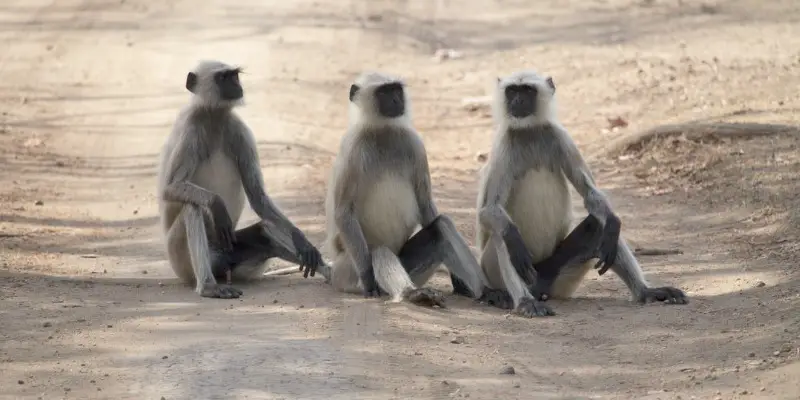
A day in the life of a baboon is, in some ways, similar to the lives of many humans. They wake up around 7:30 a.m. and spend a few minutes as a group, watching the young baboons play. Then they begin their day. They look for food, spend time eating, resting and grooming before heading back to their sleeping places at nightfall.
A group of baboons, called a troop, can number around 50 individuals. Sometimes a single troop can have as many as 250 baboons. A female member of the troop is elevated to a leadership position. While the females tend to stay with the same troops, males often wander in and out of various troops.
They Are Careful Eaters
Baboons do not eat just anything. In fact, they are quite picky about what to include in their diets. Grass is the biggest part of their diets, but baboons eat other foods as well. Some of these include berries, bark, sap, insects and, on rare occasions, a little meat.
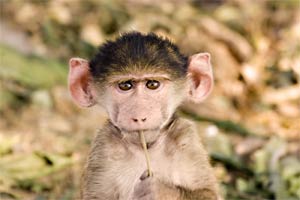
The baboon monkey is omnivorous, though the bulk of its diet is fruits, seeds, bark and roots. They do however delight in finding a vegetable garden and sampling the various plants, which makes them a pest as far as many African farmers are concerned. When the baboon does eat meat, it is usually a rodent or a bird, or a small or young mammal of one kind or another. Rather than hunting, the baboon tends more to be of an opportunistic eater. If you plant a garden or raise chickens, they will come.
Baboons Have Quite a Vocabulary
The vocabulary of a baboon includes more than 30 sounds. They also communicate through a variety of non-verbal gestures, such as shrugging.
Baby Baboons
Among the interesting baboon facts is the way that the mother cares for her young. The newborn is held by the mother until he or she is old enough to ride on her back. Baby baboons are in constant contact with their mothers for a few months. Then, when he or she is about four months old, the baboon can begin playing and interacting with the other young baboons in the troop.
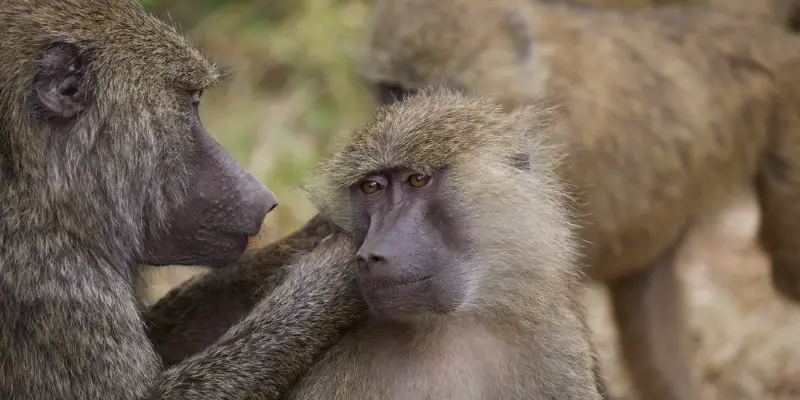
They Cannot Hang By Their Tails
Unlike monkeys, baboons cannot hang from their tails. They can, however, climb quite efficiently and do so when looking for food, sleeping or just trying to get a good look around. Baboons spend a lot of their time on the ground as they find the underbrush to be an effective method of escaping possible predators.
They Can Fight
A surprising entry on the list of baboon facts is that they are quite effective fighters. They will not typically back down from a challenge, even when the animal is much larger. In fact, they have even been known to stand their ground when feeling threatened by humans.
Their main predator is the leopard, and it often happens that a leopard is killed in a fight with one or more baboons.
Baboon’s canine teeth are longer than those of a lion, and they will use them if they need to. Before resorting to fighting, however, baboons will try to scare of predators with loud vocalizations and by striking their most intimidating poses.
This is just a few of the many interesting baboon facts. Learn all you can about these wonderful animals, including what you can do to protect them and their habitats.
Muzzles and Padded Seats
Two of the well known characteristics shared by all baboons is their canine-like snout or muzzle, and their portable seat cushions, nerveless calluses or pads on their buttocks which they enable them to sit quite comfortably. When provoked or placed in a defensive situation, the baboon will often yawn, not because it is suddenly sleepy, but to expose its rather impressive set of teeth. This practice of yawning is also used to establish dominance within the troop. Dominant males get to where they are through physical force and constantly have to rely upon that force to retain the position they have gained.
A Good, Long Life In The Wild
Probably because of their social structure, the fact that they do not have too many predators, and their eating habits, which are not particularly restrictive, baboons have a relatively long life span, about 30 years in the wild, and half again as much in captivity. In the wild, the baboon monkey may be one of the more dangerous members of the monkey family to observe except from a reasonably safe distance, but the fact that it is primarily a ground dweller makes studying this fascinating animal possible and rewarding.
